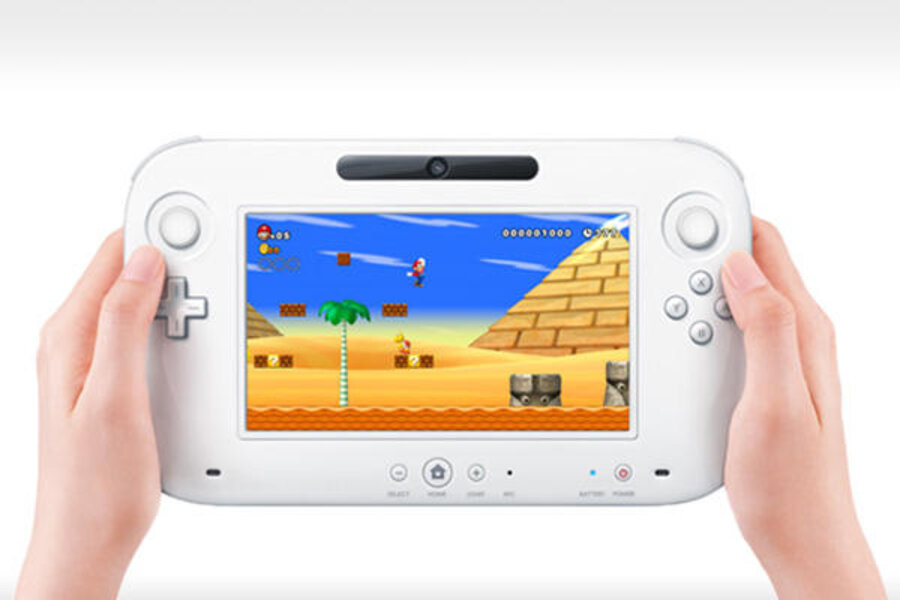Nintendo Wii U review roundup
Loading...
On Sunday, after months of hype and speculation, Nintendo finally unveiled the Wii U, the successor to the top-selling Wii video game console.
The device comes in two versions: a standard edition, with 8 gigabytes of storage, for $299; and a "deluxe" package, with 32 gigabytes of storage and the Nintendo Land game, for $349. The big selling points on the Wii U are the HD graphics – the original Wii lagged woefully behind the Microsoft Xbox 360 and the Sony PlayStation 3 in this regard – and the touchscreen GamePad controller.
So how does the Wii U stack up to other competitors in the console market? Well, let's go to the reviews.
First up, the controller. It's big, admits David Pierce of The Verge, but it actually handles pretty well.
"[T]hanks to ridges underneath your fingers in the back is quite comfortable to hold as long as it's in both hands – it's a little awkward in one hand, especially when you hold it in portrait mode," Pierce writes, adding that "the whole thing feels a little cheap and flimsy (a common occurrence with Nintendo consoles) though it's plenty sturdy in use. The build quality is one of many sacrifices Nintendo seems to make in the name of creating a lighter, smaller GamePad."
And after a little bit of use, writes Kyle Orland of Ars Technica, the thing only gets better.
"The GamePad's tilt sensitivity precision is probably its most surprising feature," Orland writes."This is best put to use in conjunction with the built-in screen to give you direct control of a first-person camera. Moving the GamePad around and seeing the image on the screen change perspective instantly (and accurately) is like looking through a portal to another world, creating a seamless bit of augmented reality that just isn’t possible on other systems."
With the GamePad, of course, comes the same sort of mobile OS you'd see on a touchscreen smartphone. And surprisingly, notes Kyle Wagner of Gizmodo, for something not made by Apple or Google, the experience is not half-bad.
"Navigating around on the gamepad is more responsive than you expect from a console OS, as are touch events and sensitivity," Wagner writes. "It's not to the level of, say, iOS or Android, but it's miles better than using the touchscreen on a [Nintendo 3DS handheld]. That's all undercut, though, but interminable load times you encounter while switching apps. Maybe that'll be fixed with an early patch (Amazon's Kindle Fire HD had enormous load times for movies and apps just a few days before it launched, but fixed them in time), but for now, it's infuriating."
As we noted last week, Nintendo is launching the Wii U with traditional fare, such as the new Super Mario game, Super Mario Bros. U. But the bulked-up Wii U is also capable of playing big-budget titles such as Call of Duty: Black Ops II and Assassin's Creed III, both of which are scheduled to hit shelves this week. And that's mostly a good thing, writes Andrew Hayward of TechRadar.
"Since multiplatform games take up such a large chunk of the launch lineup, its success depends a lot on perspective," Hayward writes. "If you're upgrading from a Wii, you'll find a large number of fantastic HD experiences that simply weren't possible on that dated hardware. For owners of Xbox 360, PlayStation 3, or a capable PC, a lot of the lineup may seem like a retread, with only a handful of titles beyond Nintendo's own games really delivering fresh experiences."
And then there's the "Miiverse" – a social network where Wii U games can create custom avatars, chat with buddies, brag about scores, or post messages to Twitter. There's no subscription fee for the Miiverse, but unfortunately, as Matt Peckham of Time found out recently, the whole place is a bit of a ghost town right now.
"I’m genuinely upbeat about Nintendo’s two-screen approach to gaming, but the online angle is a little disappointing," Peckham writes. "A bunch of stuff is still missing, the stuff that’s there has stability issues and when it works, load times are annoying. Now that we’re getting a clearer picture of how the Wii U works with the rest of its features enabled, it’s hard not to see Nov. 18 as overly optimistic – Nintendo corporate putting its 'in time for Black Friday' foot down."
We're going to give the last word on the Wii U to Stephen Totilo of Kotaku. Totilo likes the Wii U, but at this point, he counsels, it's not exactly a must-have.
"Wait until the 'launch window' closes at the end of March and the likes of Pikmin 3, Lego City Undercover and a slew of interesting download-only games are available," he writes. "With any new console you might be wisest to give it a year, especially if you want to be able to compare it to what Sony and Microsoft have coming next. And if they don't put screens in their controllers, know right now that Nintendo will have at least that excellent advantage over them."
For more tech news, follow us on Twitter @venturenaut.





